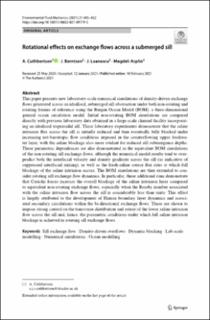| dc.contributor.author | Cuthbertson, A. | |
| dc.contributor.author | Berntsen, Jarle Peder | |
| dc.contributor.author | Laanearu, J. | |
| dc.contributor.author | Asplin, Magdeli | |
| dc.date.accessioned | 2022-05-04T12:54:55Z | |
| dc.date.available | 2022-05-04T12:54:55Z | |
| dc.date.created | 2021-08-26T16:57:46Z | |
| dc.date.issued | 2021 | |
| dc.identifier.issn | 1567-7419 | |
| dc.identifier.uri | https://hdl.handle.net/11250/2994218 | |
| dc.description.abstract | This paper presents new laboratory-scale numerical simulations of density-driven exchange flows generated across an idealised, submerged sill obstruction under both non-rotating and rotating frames of reference using the Bergen Ocean Model (BOM), a three-dimensional general ocean circulation model. Initial non-rotating BOM simulations are compared directly with previous laboratory data obtained in a large-scale channel facility incorporating an idealised trapezoidal sill. These laboratory experiments demonstrate that the saline intrusion flux across the sill is initially reduced and then eventually fully blocked under increasing net-barotropic flow conditions imposed in the counterflowing upper freshwater layer, with the saline blockage also more evident for reduced sill submergence depths. These parametric dependences are also demonstrated in the equivalent BOM simulations of the non-rotating sill exchange flows, although the numerical model results tend to overpredict both the interfacial velocity and density gradients across the sill (as indicative of suppressed interfacial mixing), as well as the fresh-saline source flux ratio at which full blockage of the saline intrusion occurs. The BOM simulations are then extended to consider rotating sill exchange flow dynamics. In particular, these additional runs demonstrate that Coriolis forces increase the overall blockage of the saline intrusion layer compared to equivalent non-rotating exchange flows, especially when the Rossby number associated with the saline intrusion flow across the sill is considerably less than unity. This effect is largely attributed to the development of Ekman boundary layer dynamics and associated secondary circulations within the bi-directional exchange flows. These are shown to impose strong control on the transverse distribution and extent of the lower saline intrusion flow across the sill and, hence, the parametric conditions under which full saline intrusion blockage is achieved in rotating sill exchange flows. | en_US |
| dc.language.iso | eng | en_US |
| dc.publisher | Springer | en_US |
| dc.rights | Navngivelse 4.0 Internasjonal | * |
| dc.rights.uri | http://creativecommons.org/licenses/by/4.0/deed.no | * |
| dc.title | Rotational effects on exchange flows across a submerged sill | en_US |
| dc.type | Journal article | en_US |
| dc.type | Peer reviewed | en_US |
| dc.description.version | publishedVersion | en_US |
| dc.rights.holder | Copyright The Author(s) 2021 | en_US |
| cristin.ispublished | true | |
| cristin.fulltext | original | |
| cristin.qualitycode | 1 | |
| dc.identifier.doi | 10.1007/s10652-021-09779-5 | |
| dc.identifier.cristin | 1929087 | |
| dc.source.journal | Environmental Fluid Mechanics | en_US |
| dc.source.pagenumber | 405-432 | en_US |
| dc.identifier.citation | Environmental Fluid Mechanics. 2021, 21, 405-432. | en_US |
| dc.source.volume | 21 | en_US |

